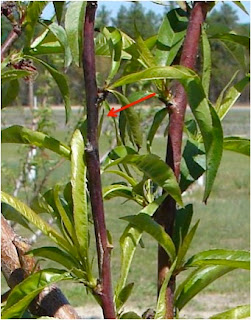My favorite time to visit the local farmers market is during peach season. To me, there is nothing tastier than slicing open a juicy peach on a hot summer day. Right now, there are three major peach diseases that you can be on the lookout for: bacterial spot, peach scab, and brown rot. The next time you visit the local market or if you have a peach tree in your backyard, try and see if you can spot some of these diseases for yourself!
Bacterial Spot
Dr. David Ritchie, the peach “disease” guy here at NCSU, says that, this year, bacterial spot is the worst he has seen since 2003 and the most damaging it has been in the past 20 years on highly susceptible cultivars. Bacterial spot is caused by the bacterium Xanthomonas arboricola pv. pruni. The most obvious leaf symptoms are yellow, chlorosis of the leaves with angular lesions at the leaf tip, mid-rib, and along the leaf margin. Premature leaf drop is common in infected leaves. Foliar lesions appear water-soaked and sometimes grayish in color. As lesions age, centers may become dark or purple in color and necrotic, eventually dropping out to result in a shot-hole appearance.
Twig symptoms consist of cankers on either side of leaf and flower buds on the previous year’s growth. These cankers are called “spring cankers” because they are first visible during bloom. “Summer cankers” can be seen on current-season growth and are visible early to mid-summer.
 |
| Bacterial Spot Twig Symptoms (Photo by D.F. Ritchie) |
 |
| Bacterial Spot Twig Symptoms (Photo by D.F. Ritchie) |
The earliest fruit lesions are normally seen about three weeks after petal all. Fruit infection is favored by moist and warm conditions with fruit being very susceptible from shuck split to pit-hardening. Developing lesions have a water-soaked appearance with small necrotic centers that become black in color and enlarge as the lesions mature. Early infections result in lesions that expand down the pit before harvest. Infections later on in the season result in shallow lesions that cause skin cracking. Attempts to control bacterial spot at this time in the season (June) are of little to no value because once the bacteria have infected, the “path” to damage has occurred.
 |
| Bacterial Spot Fruit Symptoms (Photo by D.F. Ritchie) |
 |
| Bacterial Spot Fruit Symptoms (Photo by D.F. Ritchie) |
Peach Scab
Peach scab occurs every year in North Carolina. This disease is caused by the fungus, Cladosporium (syn. Fusicladosporium) carpophilum. C. carpophilum is an asexual fungus that produces conidia and chlamydospores. The conidia are wind or water splashed dispersed and infect shoots, leaves, and fruit during the season. Chlamydospores are thick-walled survival structures that form on infected twigs during the winter. Usually the leaf infections are less noticeable and least important. The twig infections are ecologically important because they serve as the site for the production of the overwintering chlamydospores. Fruit infections result in considerable yield losses because of grade reductions or culling of affected fruit that would be less desirable in the marketplace. First fruit infection occurs during the 4-week period after bloom. The fungus has a long latent period of approximately 6 weeks before the scab lesions are observed, usually by the end of May to early June. Greenish-gray to olive circular spots form on the fruit and these spots expand in size as the disease progresses.
 |
| Peach Scab (Photo by D.F. Ritchie) |
The fungus sporulates on the fruit lesions, producing conidia that can cause secondary infections of fruit and twigs. Fruit scab lesions often have a raised, corky appearance, whereas bacterial spot lesions are often sunken in appearance. Severe infections may lead to cracking of the fruit skin, which can serve as entry points for fruit-rotting organisms like the brown rot fungus. There are no resistant varieties or cultural control options for managing peach scab. Control relies exclusively on well-timed fungicide applications starting at petal fall and making 2-3 applications during the following 4-5 weeks. Once scab is observed, fungicide sprays will have little if any controlling effect of scab on the fruit.
Brown Rot
Brown rot is most risky in warm, humid climates. Brown rot is caused by the fungus, Monilinia fructicola. This disease occurs in two phases: a twig and blossom blight phase and a fruit rot phase. Twig and blossom blight phase occurs in early spring when the trees are blooming. Infected blossoms wilt, turn brown, and usually cling to the twigs. The infections can then spread into the twigs resulting in twig cankers. Fruit susceptibility to brown rot increases during the 2 to 3 week period prior to harvest because of the increased sugar content in the fruits. Initially, tan-brown circular spots can be seen on the fruit.
 |
| Brown Rot (Photo by D.F. Ritchie) |
Under humid conditions, ash-gray-brown spore masses are visible on infected tissue. There can be thousands of spores on each lesion and each spore is capable of initiating a new infection. If conditions are wet and warm during fruit ripening, the entire crop can be destroyed overnight! Controlling this disease relies primarily on good sanitation practices combined with judicious use of fungicides. Fungicides are most effective when applied just before the blossoms open and then again during the 2-3 week period leading up to harvest.
More information on peach production and diseases can be found in the "Peach Growers Handbook"
Hopefully these diseases won't keep too many peaches from ending up in your basket at the local martket! Enjoy!
Special thanks to Dr. David Ritchie for providing his peach disease expertise and photos!

